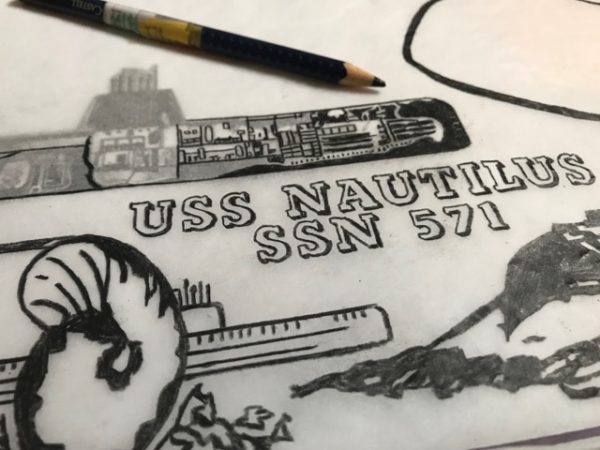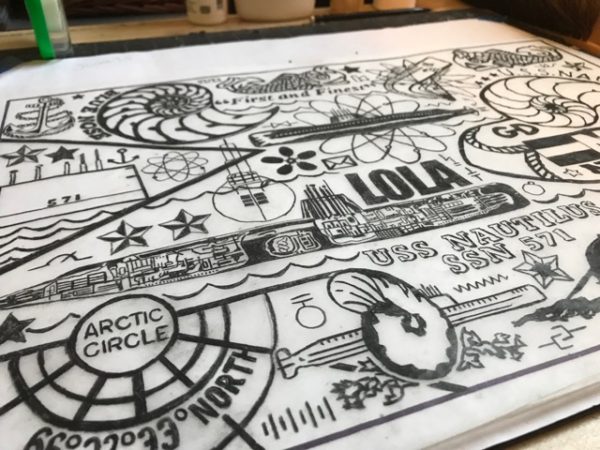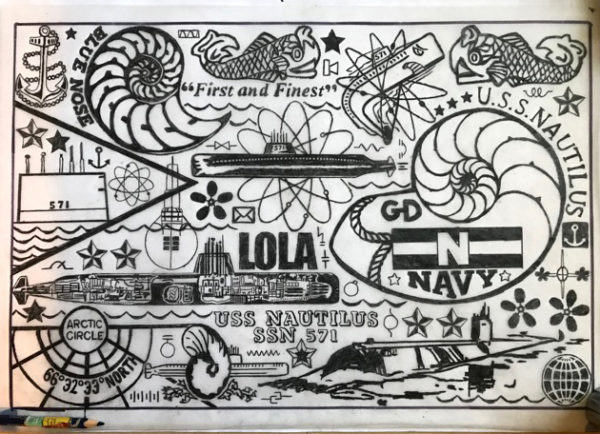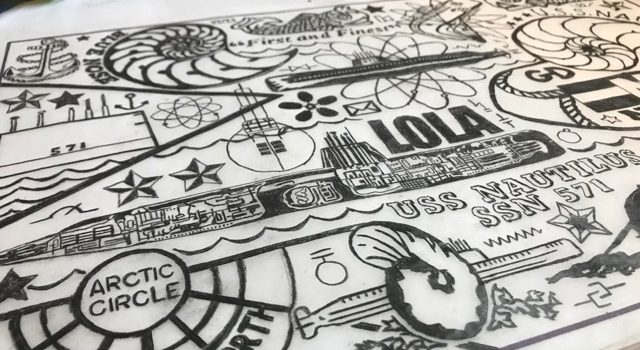Jonpaul Smith is a Cincinnati artist known for his meticulous and tightly carved linocut blocks, as well as woven paper pieces. Recently, Jonpaul took on a collaborative project, becoming a visual interpreter for a Navy veteran’s story of service.
(For more on Jonpaul’s thoughts & process, we’ll follow-up this post with part 2!)
Inspired by an interview conducted by EVAC (Experiencing Veterans and Artists Collaborations) interviewer Julie Mayle recorded with Navy veteran James A. Morley, Smith composed a design for a linocut block which will be used to pull an edition of prints.
EVAC draws from all branches of the military, putting those stories in the hands of artists. The resulting prints are displayed with excerpts of the interview transcripts, and are intended to “bridge the often precarious gap between military and civilian life.”

Using storytelling and art, EVAC bridges the gap between civilians and veterans by educating the public about life in the military.

James A. Morley was born in July of 1936. He served in the United States Navy from 1955 to 1959, a submariner aboard the USS Nautilus (SSN-571). Morley enlisted just after high school.
In an interview transcript from 2015, Morley talks about everything from telling stories with his buddies (lunch and lies, he laughingly calls it), to submarine escape drills, to the dolphin pins that submariners receive when they qualify in all compartments (and how they’re promptly thrown over the side in celebration).
The Nautilus was the first nuclear-powered submarine, eliminating a then-traditional need to surface often and recharge. Morley worked as an Electrician’s Mate 2nd class on Lola (so nicknamed because “whatever Lola wants, Lola gets”—that submarine was the future of the Navy—what her crew needed, it received), spending most of his time on electrical systems like internal communications. He received an Order of the Blue Nose patch (awarded to “maritime personnel who’ve crossed the Arctic Circle”); the Nautilus was the first submarine to voyage under the Arctic polar ice pack).
Rather than re-enlist and take a position on a surface craft, Morley left the Navy to attend Xavier, then Bowling Green (where he met his wife), and eventually University of Toledo where he earned a degree in engineering physics. He went on to work at a nuclear reactor, eventually pursued his masters in engineering, and stayed with the Department of Energy until he retired. Morley moved back to Ohio where he recorded his interview with EVAC in 2015. Below is an excerpt of one of his stories:
We had some problems with the salinity creeping into our steam system. If you get salt in there in tends to corrode things. Whenever we stopped we pulled the inspection plates off the condensers and tried to air test them to see if we could find the source. We could not find it. We were in Seattle at the time and our captain, William R. Anderson, who was a marvelous person and an excellent captain…perfect gentleman from Tennessee, he remembered the days before he was in the Navy when he would have to fix a radiator leak on cars. There was a product out called Bars Leak, which they dumped into the radiator and it would go to the point where the leak was and it would essentially freeze and plug the leak. He sent a bunch of people from the engineering gang in civilian clothes into Seattle to buy up all of the Bars Leak they could find. We took it back and put it into our steam system and that leak was plugged. And it was still in there in 1959 when we took it into the yard. Bars Leak used that as an advertisement for their products.**
**to this day it remains on the Bars Leak company’s historical timeline: 1958.

Related Links:
» EVAC Project
» EVAC Portfolio
» Jonpaul’s portfolio
» Navy history: USS Nautilus
» Bars Leaks Nautilus promo: Youtube
» further reading
